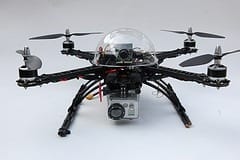Networking: Enthusiasts dream of building a drone-powered internet to carry objects rather than data. Are they mad?
THE spread of mobile phones in developing countries in the past decade has delivered enormous social and economic benefits. By providing a substitute for travel, phones can make up for bad roads and poor transport infrastructure, helping traders find better prices and boosting entrepreneurship. But although information can be delivered by phone—and, in a growing number of countries, money transferred as well—there are some things that must be delivered physically. For small items that are needed urgently, such as medicines, why not use drone helicopters to deliver them, bypassing the need for roads altogether?
That, at least, was the idea cooked up last year at Singularity University, a Silicon Valley summer school where eager entrepreneurs gather in the hope of solving humanity’s grandest challenges with new technologies. The plan is to build a network of autonomously controlled, multi-rotor unmanned aerial vehicles (UAVs) to carry small packages of a standardised size. Rather than having a drone carry each package directly from sender to recipient, which could involve a long journey beyond the drone’s flying range, the idea is to build a network of base stations, each no more than 10km (6 miles) from the next, with drones carrying packages between them.
After arrival at a station, a drone would swap its depleted battery pack for a fully charged one before proceeding to the next station. The routing of drones and the allocation of specific packages to specific drones would all be handled automatically, and deliveries would thus be possible over a wide area using a series of hops. It is, in short, a physical implementation of the “packet switching” model that directs data across the internet, which is why its creators call their scheme the “matternet”.
Over the matternet, so the vision goes, hospitals could send urgent medicines to remote clinics more quickly than they could via roads, and blood samples could be sent and returned within hours. A farmer could place an order for a new tractor part by text message and pay for it via mobile money-transfer. A supplier many miles away would then take the part to the local matternet station for airborne dispatch via drone.
Mind over matter
Andreas Raptopoulos, the entrepreneur who led the academic team, reckons that the scheme would be competitive with building all-weather roads. A case study of the Maseru district of Lesotho put the cost of a network of 50 base-stations and 150 drones at $900,000, compared with $1m for a 2km, one-lane road. The advantage of roads, however, is that they can carry heavy goods and people, whereas matternet drones would be limited to payloads of 2kg in a standard 10-litre container. But the scheme is potentially lifesaving in remote areas, and might also have commercial potential to deliver small packages in the rich world.
Since the original proposal, however, an ideological disagreement has emerged over how best to implement this drone-powered internet for objects. Two separate groups are now taking rather different approaches. The first, led by Mr Raptopoulos, has formed a company, called Matternet, to develop the drone and base-station hardware, and the software that will co-ordinate them. The company then hopes to sell the technology to government health departments and non-profit groups. Just as mobile phones have spurred development in poor countries, Mr Raptopoulos hopes drone delivery will do something similar.
The second group is called Aria (“autonomous roadless intelligent array”). It believes the matternet should be free, open and based on standardised protocols, just like the internet. It is developing these protocols and building prototypes that adhere to them, and inviting others to follow suit. Aria is not promoting any particular use of the technology, and will not necessarily build or run networks itself. “We understand there will be hundreds of applications, but we are not interested in running such applications,” says Arturo Pelayo, Aria’s co-founder. “We won’t aim for understanding every single geographical and cultural context where the system might be used.”
The Economist
The Latest Streaming News: Internet of airborne things updated minute-by-minute
Bookmark this page and come back often
Latest NEWS
Latest VIDEO








